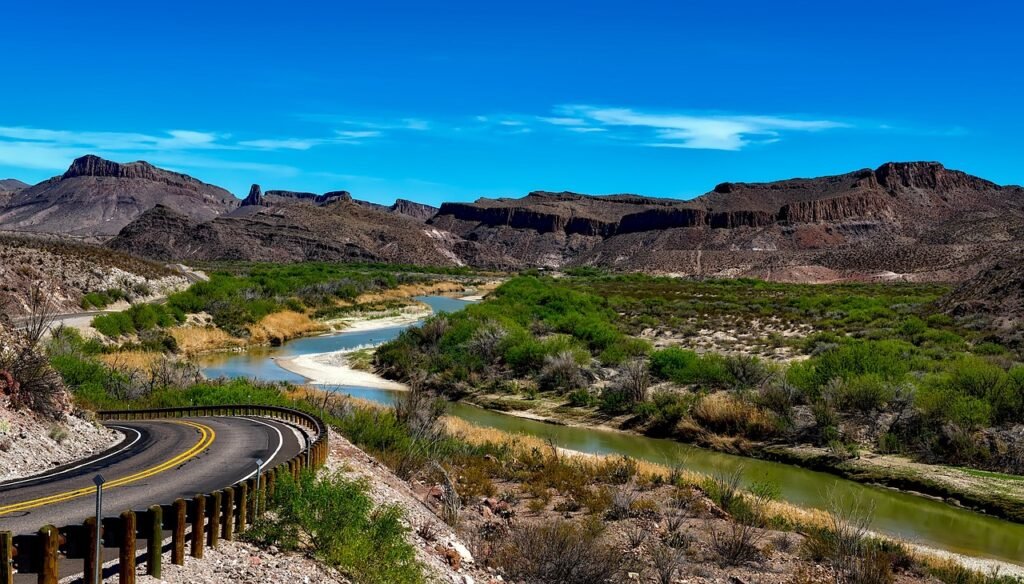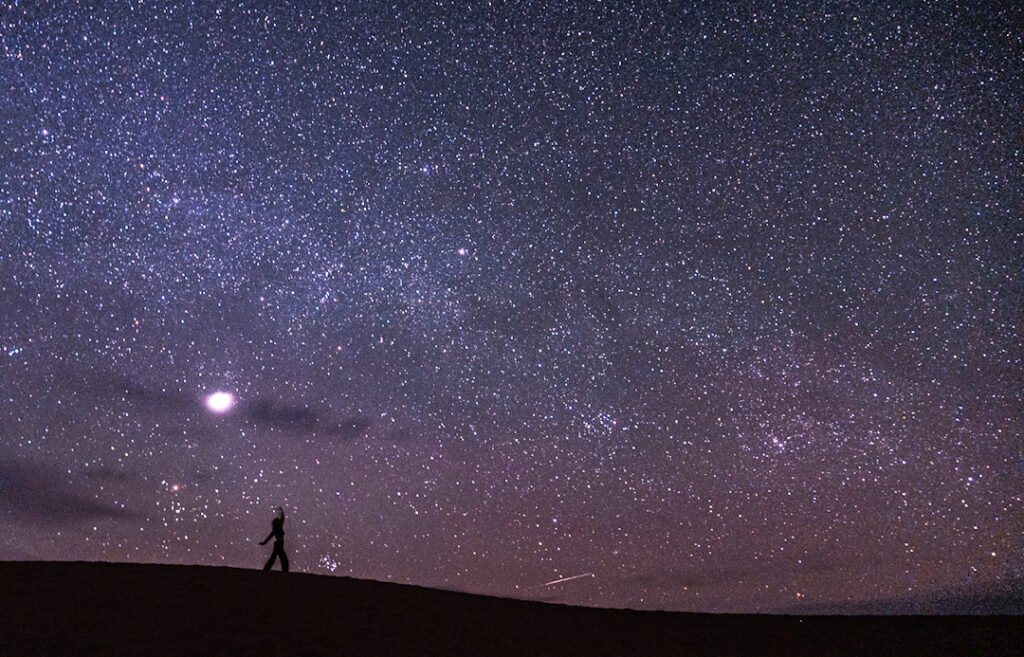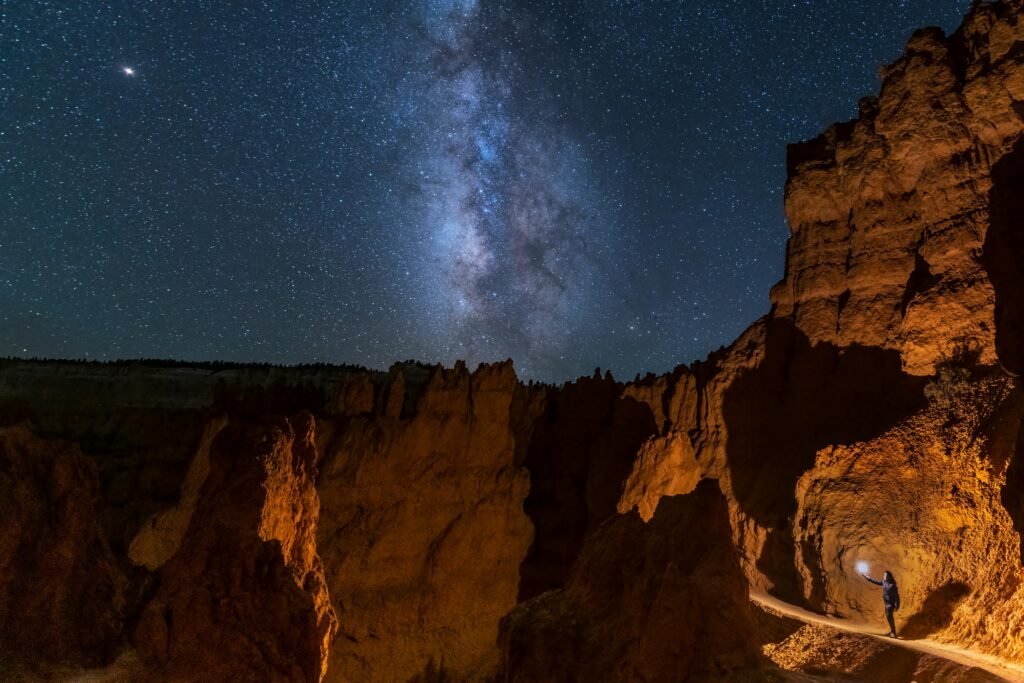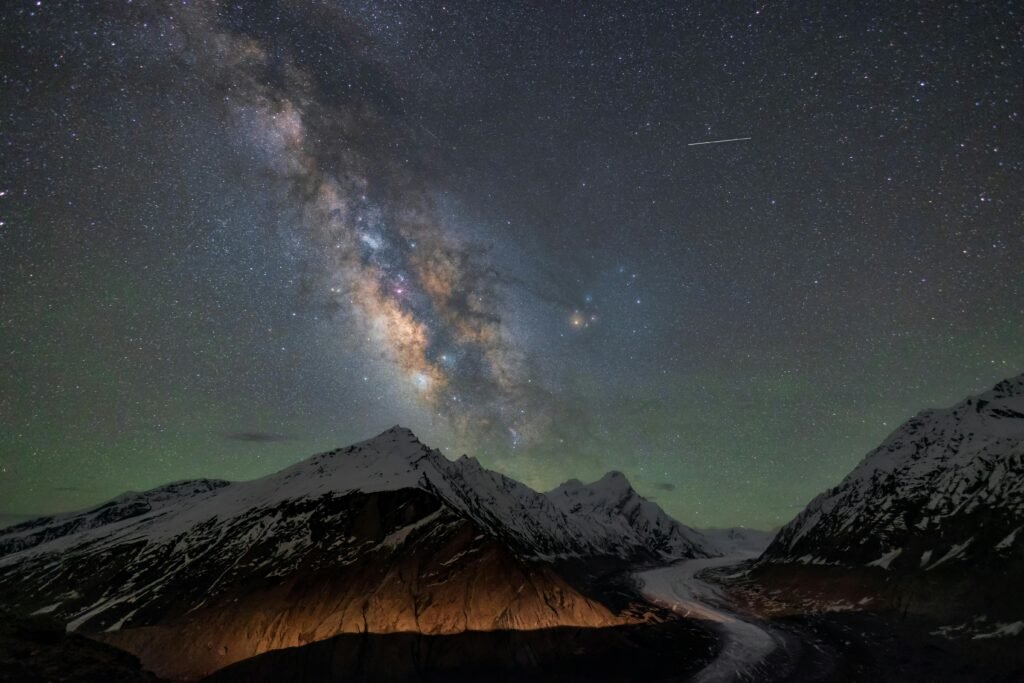*This post may contain affiliate links. If you make a purchase through one of these links, I may earn a small commission at no extra cost to you. Read my full disclaimer here.
Some of the most awe-inspiring moments I’ve had outdoors didn’t happen during the day — they happened under a sky so full of stars it didn’t feel real. Whether it’s watching the Milky Way rise over the desert or capturing long exposures in total silence, night photography in national parks has a magic all its own.
In this guide, I’m sharing 6 of the best national parks for stargazing and astrophotography – places that have left me speechless after dark with truly dark skies, beautiful landscapes, and the kind of stillness that stays with you. I’ve also included tips for shooting at night, a few favorite campsites, and the gear that helps bring it all to life.
*I put together a list of my Top Astrophotography Gear Picks to help you capture stunning night sky shots:
What Makes These Parks Perfect for Stargazing?
Here’s what I looked for when narrowing down the list to these six incredible parks:
1. Dark Skies: Low light pollution and remote locations make for skies packed with stars.
2. Accessibility: You shouldn’t have to trek for days to reach the best spots! These parks offer accessibility for both beginner explorers and seasoned adventurers.
3. Photographic Hits: Iconic landscapes, natural features, and conditions that make for jaw-dropping photography.
1. Big Bend National Park, Texas

Why It’s Amazing
Big Bend boasts some of the darkest skies in the U.S., thanks to its remote location, minimal development, and strict light pollution controls. Located in southwest Texas, this national park spans over 800,000 acres of rugged desert landscapes, dramatic canyons, and towering mountain ranges. At night, the clear, dry air and absence of light pollution create perfect conditions for stargazing and astrophotography. Visitors can capture stunning views of the Milky Way, constellations, and even distant galaxies with incredible clarity. Big Bend has also been designated an International Dark Sky Park, making it a haven for astronomy enthusiasts and photographers alike. Pair the dazzling night sky with the park’s unique desert terrain, and your photos will have both striking depth and character. Whether you’re an amateur stargazer or a seasoned astrophotographer, Big Bend offers an unforgettable experience.
Best Stargazing Spots
- Panther Junction: Perfect for beginners with easy access.
- Chisos Basin: Offers dramatic vistas with mountain backdrops.
- Sotol Vista Overlook: Iconic for Milky Way views.
Photography Tips
Grab your wide-angle lens and embrace the opportunity to experiment! The rugged landscape is rich with foreground details, perfect for adding depth and perspective to your shots.
Where to Stay
- Camping: Chisos Basin Campground, Rio Grande Village Campground, Cottonwood Campground
- Lodging: → Book hotels and rentals here
2. Death Valley National Park, California

Why It’s Amazing
Notorious for its extreme daytime conditions, Death Valley National Park transforms at night into a tranquil haven, offering some of the darkest skies in the United States. As an International Dark Sky Park, it boasts exceptionally low light pollution, making it a prime destination for stargazing and astrophotography. The vast, open landscapes, like the Mesquite Flat Sand Dunes and Badwater Basin, provide stunning foregrounds for capturing the Milky Way, constellations, and meteor showers. During moonless nights, the clarity of the stars is unparalleled, creating a magical experience for astronomy enthusiasts and photographers alike. Whether you’re a professional or a beginner, Death Valley’s night skies promise an unforgettable celestial spectacle.
Best Stargazing Spots
- Badwater Basin: The vast, flat salt flats reflect the starry sky beautifully.
- Zabriskie Point: Great for combining landscapes and stars.
- Mesquite Flat Sand Dunes: Contrast the stars with the sweeping desert dunes.
Photography Tips
Focus on capturing Milky Way shots and experiment with long exposures for star trails.
Where to Stay
- Camping: Furnace Creek, Sunset, Texas Springs, Mesquite Spring, Stovepipe Wells Campground
3. Bryce Canyon National Park, Utah

Why It’s Amazing
Bryce Canyon’s distinctive hoodoos (those unique sandstone formations) take on a surreal, almost otherworldly vibe under the night sky, creating a stunning backdrop for stargazing and astrophotography. As one of the few certified International Dark Sky Parks, Bryce Canyon offers some of the clearest, most breathtaking night skies in the country. With minimal light pollution and high elevation, the park is an ideal spot to admire the Milky Way, spot constellations, and even glimpse celestial events like meteor showers. Bonus? The park’s incredible night sky programs, including ranger-led astronomy sessions and telescope viewings, make it a must-visit destination for night sky enthusiasts.
Best Stargazing Spots
- Bryce Amphitheater: Iconic views with plenty of open space.
- Sunset Point: Not just for sunsets, but perfect for moonlit hoodoo shots.
- Rainbow Point: Offers high elevation and fewer crowds.
Photography Tips
Use star photography to highlight the hoodoos. A flashlight or small LED panel can help gently light up formations in the foreground without losing that nighttime magic.
Where to Stay
- Camping: North Campground and Sunset Campground
- Lodging: → Book hotels and rentals here
4. Grand Teton National Park, Wyoming

Why It’s Amazing
The towering Tetons juxtaposed against a starry sky? Chef’s kiss. Grand Teton National Park offers some of the most breathtaking nighttime views in the country, thanks to its high elevation, low light pollution, and dry, crisp air. These ideal conditions make it a haven for stargazing and astrophotography. On a clear night, you’ll see the Milky Way stretching across the sky, countless constellations twinkling brightly, and even the occasional meteor. The park also offers ranger-led astronomy programs during the summer, where you can learn about the stars, planets, and the unique celestial features visible from this pristine wilderness. Whether you’re a seasoned photographer or simply love the magic of the night sky, the Tetons provide an unforgettable experience under the stars.
Best Stargazing Spots
- Jenny Lake Overlook: Great for reflections of the Tetons and night skies.
- Signal Mountain: Gives a vast, sweeping view of the stars.
- Snake River Overlooks: Combine iconic landscapes with star photography.
Photography Tips
Focus on reflections of the Milky Way off Jenny Lake’s waters for ethereal results.
Where to Stay
- Camping: Signal Mountain Campground, Colter Bay Campground, Jenny Lake Campground, Gros Ventre Campground.
- Lodging: Jackson Hole offers plenty of cozy options, including The Wort Hotel, Amangani, Teton Mountain Lodge, and Four Seasons Resort. For those looking to stay within the park, consider lodges like Jackson Lake Lodge or Colter Bay Village for a more immersive experience.
- → Book lodging here
5. Glacier National Park, Montana

Why It’s Amazing
Glacier National Park offers a remote wilderness feel with high elevation, making it perfect for spectacular stargazing unhindered by light pollution. As one of the few officially designated International Dark Sky Parks, Glacier boasts some of the clearest night skies in the country, where you can gaze at countless stars, constellations, and even the Milky Way with stunning clarity. The park’s vast open spaces, such as Logan Pass and the shores of Lake McDonald, provide ideal locations for astrophotography, offering dramatic landscapes to pair with celestial phenomena. Visitors may also catch glimpses of meteor showers or even the northern lights during certain times of the year, making Glacier a dream destination for astronomy enthusiasts.
Best Stargazing Spots
- Logan Pass: Incredible high-elevation views.
- Lake McDonald: Capture star reflections on its calm waters.
- Many Glacier Area: Dramatic peaks and ideal dark skies.
Photography Tips
Pack some patience and be ready to stay late. Use a headlamp with a red light setting to prevent losing your night vision during setup.
Where to Stay
- Camping: Apgar Campground, Rising Sun Campground, Fish Creek Campground
- Lodging: → Book lodging here
6. Joshua Tree National Park, California

Why It’s Amazing
Known for its unique desert trees and dreamy landscapes, Joshua Tree’s remote location offers pristine, unpolluted skies, making it a haven for astro enthusiasts and photographers alike. Designated as an International Dark Sky Park, Joshua Tree boasts minimal light pollution, allowing for breathtaking views of the Milky Way, countless constellations, and even meteor showers. The park’s rugged terrain, with its striking boulders and iconic Joshua trees, provides a stunning foreground for night photography. With several stargazing spots like Hidden Valley and Keys View, and regular astronomy programs hosted by the park, it’s an ideal destination for anyone looking to immerse themselves in the beauty of the night sky.
Best Stargazing Spots
- Hidden Valley Campground: Easy access with excellent views.
- Keys View: Great for sunrise-to-star views in one visit.
- Arch Rock: Iconic foreground for capturing star trails.
Photography Tips
Shoot during new moon phases for the darkest skies, and consider venturing out after midnight to avoid any remaining crowds.
Where to Stay
- Camping: Hidden Valley Campground, Jumbo Rocks Campground, or Indian Cove Campground
- Lodging: → Book hotels and rentals here
Essential Gear for Astrophotography:
- Tripod
- Avoid shaky shots with a steady tripod.
- Recommendation: Peak Design Tripod for durability, portability, and advanced design features.
- Camera
- Capture stunning night skies with a professional camera.
- Recommendation: Sony a7IV for exceptional performance.
- Wireless Remote Shutter Release
- Perfect for long-exposure star photos.
- Recommendation: Pixel TW-283 for reliable performance at a great price.
- Wide-Angle Lens
- Ideal for expansive night sky shots with stunning clarity.
- Recommendations:
- Headlamp with Red Light Mode
- Illuminate your surroundings without affecting your night vision.
- Recommendation: Petzl Actik Core Headlamp
- Star Tracker
- For advanced astrophotography, a star tracker ensures crisp, detailed images of celestial objects.
- Recommendation: Sky-Watcher Star Adventurer 2i
- Extra Batteries and Memory Cards
- Long nights require extra power and storage. Always carry spares to avoid interruptions.
- Recommendation: SanDisk 256GB Extreme PRO SDXC UHS-II Memory Card
Adventure Awaits Under the Stars
Each of these parks offers something uniquely magical, from breathtaking mountain silhouettes to alien-like desert landscapes. Whether you’re looking to capture the Milky Way in all its glory or simply enjoy the beauty of untouched night skies, these national parks are perfect for your next adventure.
Book your trip at Recreation.gov and start planning your next stargazing adventure!
Don’t forget to check out my blog on my Top Astrophotography Gear Picks to capture the perfect night sky shot.
